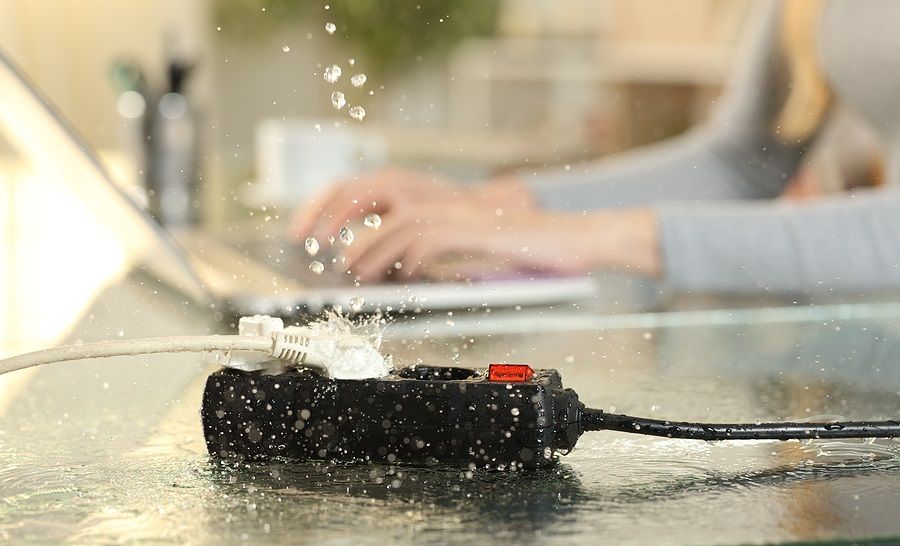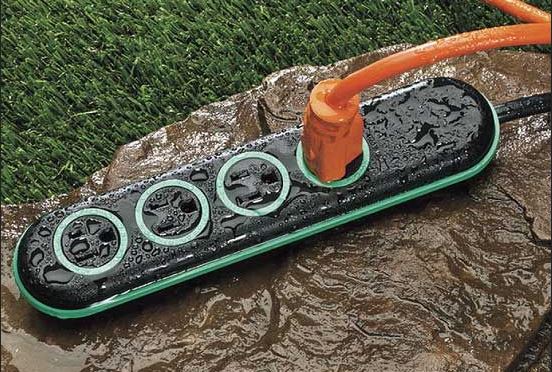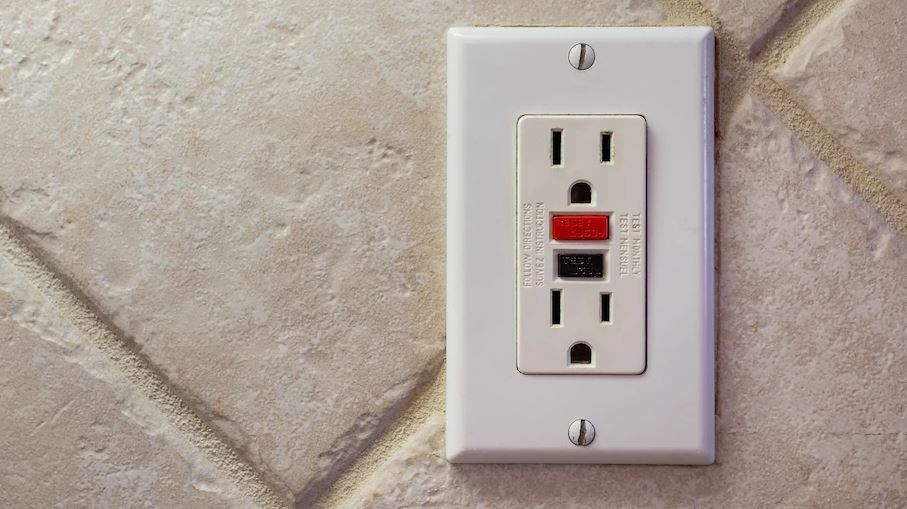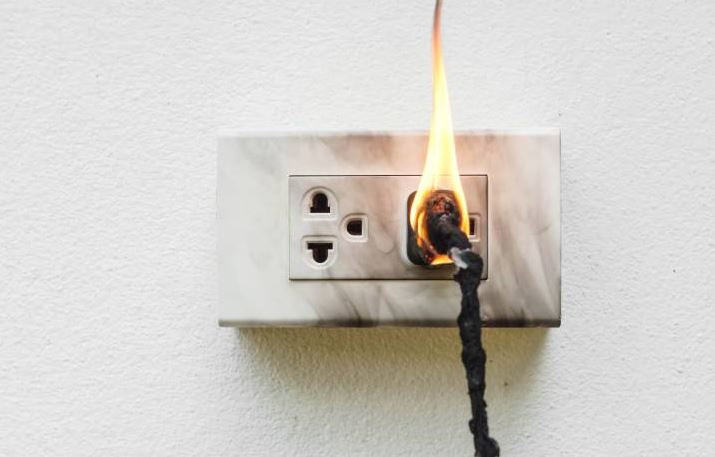What To Do If Your Electrical Outlet Gets Wet?

We have all heard how dangerous the combination of electricity and water is. For this reason, electrical outlets can pose a great problem if placed in a room with high moisture levels and water. This can be really dangerous, and to avoid any unpleasant situation, we’ll talk about the steps you need to do if your electrical outlet gets in touch with water.
What To Do if Your Electrical Outlet Gets Wet? If an electrical outlet is wet, turn off the circuit breaker in your home and dry the outlet. Also, damaged outlets need to be replaced with the new ones. Outlets exposed to water raise the odds of an electric shock for anyone in the direct vicinity of the outlet and could even result in a fire.
The issue is further complicated when it comes to exterior electrical outlets, which are exposed to weather conditions such as rain and storms. However, the solution for this issue is rather simple, enclose the outlets in protective casings and be sure not to install the outlets near water. We’ve already mentioned the consequences, and with solutions being this easy, it’s better not to take the risk.
Causes of Wet Electrical Outlets

Since both outlets and water pipes are installed into the wall, it isn’t uncommon for pipes to burst and then flood and damage your electrical outlets. Furthermore, floods caused by natural or unnatural causes (leaving the bathtub running for too long) could also pose a threat to your electrical outlets. This is also the reason why electrical outlets aren’t installed close to the floor.
Subsequently, one of the other main sources of leaks is the roof. Roof leakage can potentially cause damage to all your electrical installations, and outlets are not excluded. What’s more important is, in fact, how to deal with an outlet that has come in contact with water, and that is what we will explain in this article.
If you want to learn more about outlets, be sure to read What Is A Self-Grounding Outlet? (Explained).
What Are Code Requirements For Exterior Outlets?
When it comes to installing exterior outlets, there are certain rules and regulations that need to be followed. One of the rules is that accessory buildings, residential structures, garages, or any other similar type of building need to have an electrical outlet at ground level. This is prescribed and specified by the NEC (National Electrical Code).
Furthermore, there are specific regulations for exterior outlets which could come in contact with water or moisture, depending on where they are installed. These outlets should also contain a weather-proof cover and a weather-resistant enclosure to protect them from unfavorable weather conditions or simply moisture which is common for outlets installed on closed porches.
If you own an older house and the external outlets do not adhere to the code, it is advised that you upgrade them to fit the latest regulations. This includes installing a weather-proof cover, which serves as protection while a cord is plugged in, and a weather-resistant enclosure that protects the outlet while it is not being used. Try to follow the newest codes and regulations to keep your household safe and save your budget from unwanted fines.
GFCI Outlets Are Required By NEC

An extremely helpful addition safety-wise to your external outlet since a GFCI outlet or GFCI breaker prevents short circuit injuries if it is used as protection on an external outlet or branch circuit. Not to mention that this addition is also obligatory and specified in the NEC.
It is especially useful for individuals who take up gardening since it protects them from short circuit injuries in the unfortunate case that your garden tools have somehow been damaged and wet grass has been used as a conductor. In this case, it’s definitely better to be safe than sorry.
AFCI Outlet Protection
The AFCI (Arc Fault Circuit Interrupter) is another form of protection that could prove helpful in ensuring the safety of your household and yourself. The AFCI outlet protection prevents electrical fires by tripping the receptacle when there is a chance that arcing might occur. Arcing is a side-effect of electricity that jumps from one hot connection to another. This creates sparks and could result in a fire if it isn’t noticed or stopped on time.
Unfortunately, this type of outlet isn’t as useful when it comes to water protection since it acts the same way as a normal outlet would. The same dangers apply as with the standard outlet, including short circuits, which create further issues and could prove harmful.
Related article: Can You Put An Electrical Outlet Under A Sink?
Common Problems With Wet Electrical Outlets

Most electrical outlets are 15-amp outlets which can be easily recognized by their standard look: a d-shaped or round hole that is situated below and between two parallel slots. Unfortunately, these standard outlets don’t contain any protection from water hazards, and handling them when wet can be extremely dangerous. Not to mention the damage they can cause to your household.
Potential Fire Hazard
Not only can short circuits cause injuries, but it can also start fires if left unattended and ignored. This is actually one of the most common causes of household fires. All this could happen if your outlet comes in contact with water. The minerals in the water serve as conductors and could cause short circuits.
Problem With Corrosion
The most common issue caused by water-induced corrosion is that the device or house appliance you’ve plugged in won’t work. This is due to the damage caused by water to the connections inside the outlet.
The bigger issue arises when screw connectors corrode to the point of breaking, leaving the electrical circuit hot. The electrical outlet is completely useless once this happens, but it might also result in a short circuit or electric shock and severe injuries.
Potential Electrical Shock
This is where GFCI outlets come in handy. If the area in which the outlet is placed contains high levels of moisture or if the floors are soaked for some reason, the water beneath your feet could create a pathway to you. This could cause severe injuries from electrocution or electric shock.
For those who have problems with the lack of outlets in the kitchen, read Can Refrigerators Share An Outlet?
Indoor Electrical Outlets Are Also Prone To Water Damage
Even though external outlets are more susceptible to water damage due to weather conditions, floods, storms, or something else, outlets installed in the house’s interior are definitely not immune to this issue. Indoor outlets could prove to be more dangerous than external ones. Here are some of the reasons why:
Problem With Water Leaks
Water leaks are problematic on their own, be it visible or non-visible ones. But when you count in the fact that pipe leaks inside of walls could permanently damage your electrical installations and outlets, the problem gets even worse. Whenever something like this occurs, you should immediately presume that your outlets have been damaged and ask for professional assistance when assessing the damage.
As we’ve previously mentioned, roof leaks could also occur, especially in older households. It is also impossible to exclude leaky windows, which could also damage your outlets. The three most common leaks are the ones we’ve mentioned: pipes, roofs, and windows.
Potential Spills
The occasional mishaps such as spills and splashes could happen to anyone, especially in areas such as the kitchen or the bathroom, where water usage is at its highest. According to the National Electrical Code, these outlets must be protected by a GFCI outlet to prevent short circuits and corrosion.
Flooding Problems
Even if a flood doesn’t leave your home in ruins, that doesn’t mean that damage hasn’t been done. If floods are common in your area, and if your home has been flooded, one of the first steps, once the water is gone, is to check out your electrical installations. This includes electrical outlets. You might have to switch out some parts, but at least you’ll ensure the safety of everyone living in the house.
Here is an interesting video that shows what really happens when water comes in touch with an electrical outlet. You’ll be suprised.
What To Do With A Wet Electrical Outlet?
Now to finally give you the solution to the problem we’ve examined so thoroughly: what should you actually do if your electrical outlet comes into any type of contact with water, moisture, or dampness? Follow the steps below to resolve the issue with wet electrical outlets in the safest way possible.
1. Turn Off Your Home Electricity
The circuit breaker is a device that allows electricity to flow into your electric outlets. By turning off the correct circuit breaker, you will cut off the power supply to your outlets and thus ensure that there is no subsequent damage. Be sure to turn off the circuit breaker responsible for powering the branch circuit of the outlet. The device can be found in the service panel box.
2. Stop the Water Source
Make sure to prevent any additional water from entering the outlet. This implies finding out where the water is leaking from, be it pipes, roof, or any other source. Do not try to fix the outlet before you are certain you’ve stopped the water flow.
Doing this is a bit trickier for external outlets for obvious reasons (rain, storms, etc.). In this case, your best option is to contact a professional electrician who can install appropriate environmental protection, such as the GFCI outlet.
3. Replace Wet Electrical Outlets
Just as with the external outlet, the best option is to contact a professional electrician who will advise you whether you should replace the outlet or not. Ideally, any outlet which has come in contact with water or moisture should be replaced for safety reasons which we’ve mentioned above.
If replacement is unnecessary or isn’t an option, you could try to leave a moist outlet to dry overnight and use a blow drier to dry it off completely. Make sure not to touch the outlet while it is wet since it could lead to electric shock.
To conclude, make sure to follow all the safety regulations and rules when it comes to installing outlets since they could damage your house and cause severe injuries if not attended to or installed properly.
When it comes to areas and rooms with high moisture levels or possible splashes, try to install the outlet as far from the water source as possible. External outlets require special protection and should adhere completely to the National Electrical Code.
Related article: What Size Breaker Does A 4500 Watt Water Heater Need?
FAQ: People Also Ask
How long does it take for a socket to dry out?
This depends on a few factors: how long the socket was in contact with water, how much water has come in contact with the outlet, and whether it was water or moisture. If the damage isn’t too severe, the socket should dry in the span of 10 to 12 hours. This process can be sped up by using a blow drier.
Will a wet outlet dry out?
Depends on the severity of the water damage. Minor exposure to water shouldn’t cause a problem and the socket will dry completely in 10-12 hours.
Final Thoughts
Even though water exposure can cause severe damage to electrical outlets, there is nothing to fear if you know what you’re doing. Nevertheless, calling an expert electrician is always the best option. Make sure to check your electrical outlets regularly and ensure that they are not affected by high levels of moisture or water leaks.
If your electrical outlets are somehow exposed to water, turn off the circuit breaker, prevent water from reaching the outlet again and, optimally, replace the outlet. Make sure to follow the NCE at all times to ensure maximum safety.
